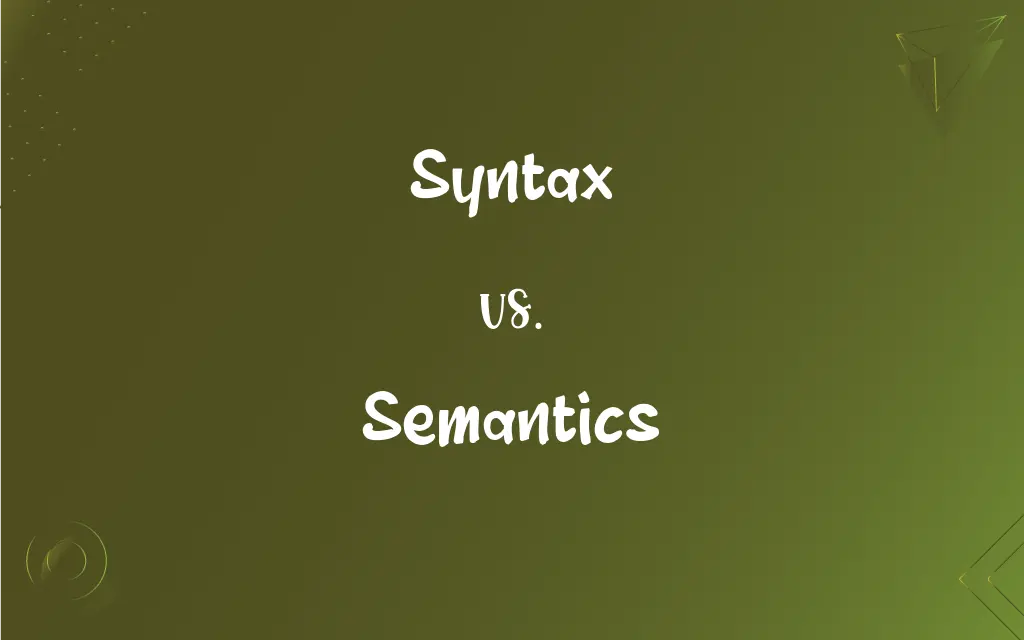Syntax vs. Semantics: What's the Difference?
Edited by Aimie Carlson || By Janet White || Published on February 19, 2024
Syntax is the set of rules for constructing sentences in a language, while semantics is the meaning conveyed by those sentences.

Key Differences
Syntax refers to the structure or format of sentences in a language, such as grammar and word order, while semantics deals with the meanings and interpretations of the words and phrases within that structure. Syntax is about the arrangement of words, ensuring grammatical correctness, whereas semantics is concerned with the conveyed message, interpreting what the words mean together.
In syntax, the focus is on the rules that govern how sentences are formed, such as subject-verb agreement and tense consistency. In contrast, semantics is about understanding the implications and connotations of a sentence, such as figurative language and contextual meanings. Syntax ensures that a sentence is correctly assembled; semantics ensures the sentence communicates the intended idea.
Syntax does not deal with the truth or reality of a statement, it is solely concerned with its grammatical correctness. Semantics, on the other hand, involves the truthfulness and the relationship of the sentence to the world, such as whether it makes sense or is logically consistent. Syntax is about form; semantics is about substance.
The study of syntax is concerned with analyzing how different words (nouns, verbs, adjectives, etc.) are combined to form sentences, following language-specific syntactical rules. Semantics looks at how meaning is conveyed in a sentence, taking into account factors like cultural context, speaker intent, and historical usage. Syntax examines sentence construction; semantics delves into the interpretation of that construction.
Syntax can be thought of as the skeleton of a language, providing a framework for constructing sentences, while semantics is like the soul, infusing sentences with meaning and depth. A syntactically correct sentence might not always be semantically meaningful, and vice versa. Syntax is the 'how' of sentence construction; semantics is the 'what' it communicates.
ADVERTISEMENT
Comparison Chart
Definition
Rules for structuring words in sentences.
The meanings and interpretations of words and sentences.
Focus
Grammar, word order, and sentence structure.
Meaning, connotation, and implication of words and phrases.
Concern
Correct assembly of sentences.
Truthfulness, sense, and relevance of sentences.
Relation to Language
Structure and form of language.
Content and meaning within the language.
Example
"The cat sat on the mat" is syntactically correct.
"Time flies like an arrow" has multiple semantic interpretations.
ADVERTISEMENT
Syntax and Semantics Definitions
Syntax
Set of rules for sentence structure.
The quick brown fox jumps over the lazy dog.
Semantics
Understanding linguistic meaning.
Break a leg is used to wish good luck.
Syntax
Arrangement of words to create meaningful sentences.
She loves chocolate.
Semantics
Study of meaning in language.
The pen is mightier than the sword implies the power of words.
Syntax
Framework for organizing words in a language.
He ran quickly.
Semantics
Meaning conveyed by language.
It's raining cats and dogs means it's raining heavily.
Syntax
The grammatical structure of sentences.
Birds chirp.
Semantics
Interpretation of words and sentences.
I'm feeling blue means feeling sad.
Syntax
System governing word order and relationships.
Can you help me?
Semantics
Analysis of what language communicates.
Apple of my eye refers to someone cherished.
Syntax
The study of the rules whereby words or other elements of sentence structure are combined to form grammatical sentences.
Semantics
The study or science of meaning in language.
Syntax
A publication, such as a book, that presents such rules.
FAQs
Can a sentence be syntactically correct but semantically wrong?
Yes, sentences can be grammatically correct (syntactically right) but make no logical sense (semantically wrong).
Are semantics concerned with literal or figurative meaning?
Semantics deals with both literal and figurative meanings of language.
What is syntax in language?
Syntax is the set of rules and principles that govern the structure of sentences in a language.
What does semantics refer to in linguistics?
Semantics refers to the study of meaning in language, including the meanings of words, phrases, and sentences.
How does syntax relate to grammar?
Syntax is a part of grammar focusing specifically on the structure and arrangement of elements within sentences.
How does context influence semantics?
Context can greatly influence the interpretation and meaning of language, which is a key aspect of semantics.
How do semantics affect communication?
Semantics affect how effectively a message is conveyed and understood, as it involves the interpretation of meaning.
Is learning syntax important for language learners?
Absolutely, as it helps in constructing grammatically correct and coherent sentences.
Are idioms a part of syntax or semantics?
Idioms primarily relate to semantics, as they are about the meaning that is not directly inferred from the individual words.
Does syntax vary between languages?
Yes, syntax varies significantly across languages in terms of rules and sentence structures.
Can semantics change over time?
Yes, the semantics of words and phrases can evolve with cultural and linguistic shifts.
Can syntax alone convey a complete meaning?
Syntax organizes words into sentences, but semantics is needed to interpret and understand the meaning.
Why is syntax important in language?
Syntax is crucial for creating well-formed, understandable sentences that follow the grammatical rules of a language.
Does semantics cover non-literal language?
Yes, semantics includes the study of non-literal and figurative language meanings.
Is punctuation a part of syntax?
Yes, punctuation is considered part of syntax as it helps in structuring sentences correctly.
How do metaphors relate to semantics?
Metaphors are a semantic concept, as they involve understanding and interpreting figurative meanings.
Is syntax more about rules or creativity?
Syntax is more about rules governing sentence structure, though creative language use can bend these rules.
Can a sentence's semantics be ambiguous?
Yes, a sentence can have multiple semantic interpretations, especially in the case of figurative or complex language.
Do syntax and semantics work independently in language?
They are interrelated but distinct aspects of language; syntax is about structure, while semantics is about meaning.
How do connotations relate to semantics?
Connotations are an aspect of semantics, involving the associated or implied meanings of words.
About Author
Written by
Janet WhiteJanet White has been an esteemed writer and blogger for Difference Wiki. Holding a Master's degree in Science and Medical Journalism from the prestigious Boston University, she has consistently demonstrated her expertise and passion for her field. When she's not immersed in her work, Janet relishes her time exercising, delving into a good book, and cherishing moments with friends and family.
Edited by
Aimie CarlsonAimie Carlson, holding a master's degree in English literature, is a fervent English language enthusiast. She lends her writing talents to Difference Wiki, a prominent website that specializes in comparisons, offering readers insightful analyses that both captivate and inform.







































































